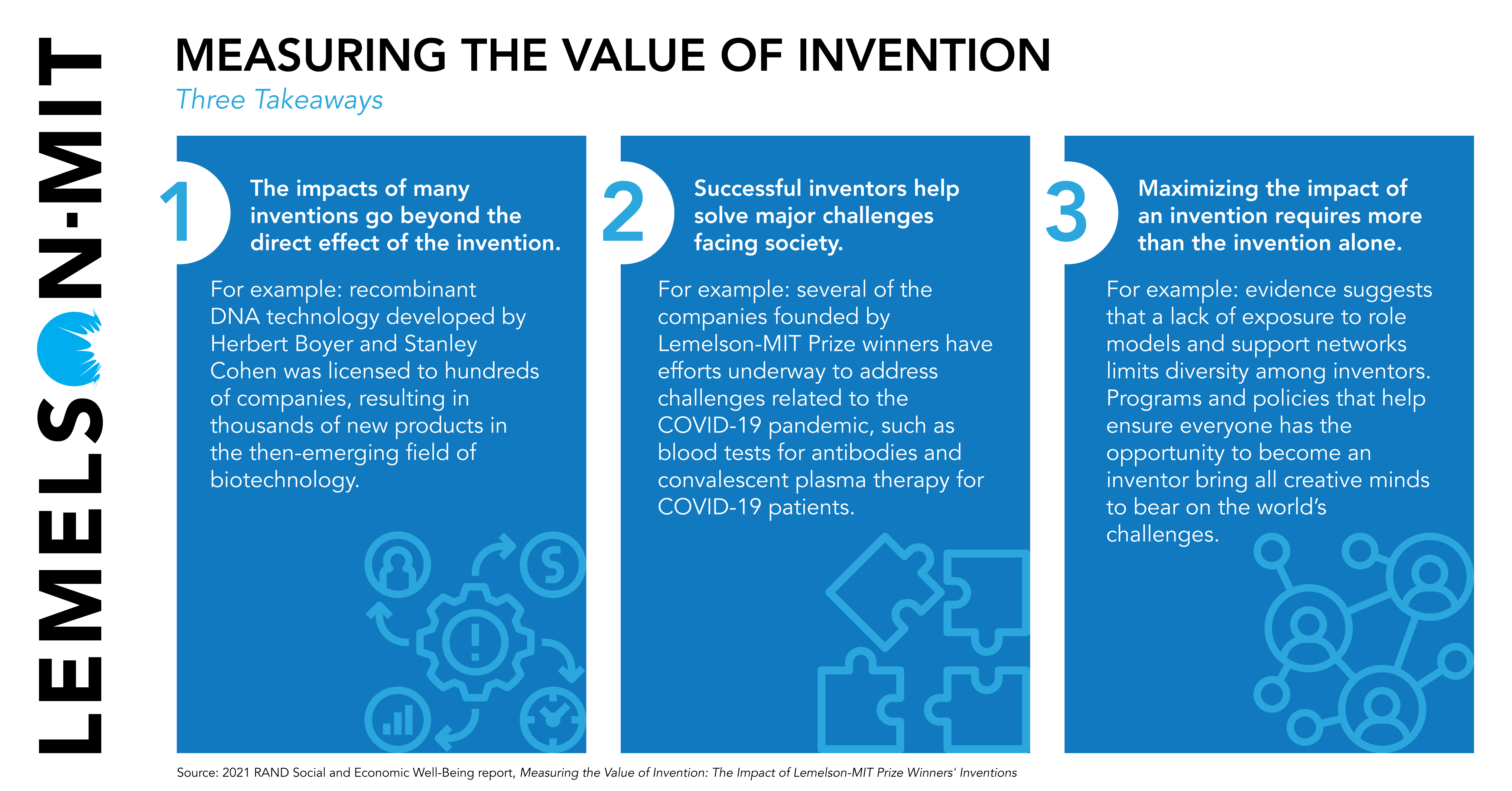Key Findings of "Measuring the Value of Invention"
Economic Impact
- The 26 Lemelson-MIT Prize winners were affiliated with more than 180 companies and institutions, founding more than 140 of them to develop or commercialize new inventions.
- The independent companies founded by Prize winners that are still in operation and report financial data collectively employ approximately 40,000 people and generate total annual revenues exceeding $54 billion as of 2019.
- Two companies founded by Prize winners were among the first biotechnology firms to achieve a market capitalization exceeding $100 billion. Several other publicly traded firms founded by winners had market valuations between $100 million and $50 billion as of 2020.
- At least 35 of the companies affiliated with the winners were acquired or merged with other companies in deals valued at approximately $7.5 billion (in 2019 dollars).

Technological Impact
- The 26 winners held 3,871 patents for original inventions deemed to be “novel, non-obvious and useful” by the US Patent and Trademark Office (as of January 2020).
- The patents were cited as prior art by over 40,000 subsequent patent applicants, which demonstrates that they served as material inputs to future inventions by others.
- 5,972 unique organizations were identified as having drawn on the winners’ original patents as they looked for citations for new patents.
- The winner’s patents spanned a wide range of technological classifications, with the greatest number falling in the “medical or veterinary sciences and hygiene” innovation category.
Scientific Impact
- The 26 winners have published over 3,700 articles that have accumulated over 334,000 citations (as of March 2020).
- Winners’ articles were published in 682 different journals and were assigned 8,327 unique “Keyword Plus” keywords, demonstrating substantial breadth in the scientific content covered.
Three Takeaways
Measuring the Value of Invention
For example: recombinant DNA technology developed by Herber Boyer and Stanely Cohen was licensed to hundreds of companies, resulting in thousands of new products in then-emerging field of biotechnology.
For example: several of the companies founded by Lemelson-MIT Prize winners have efforts underway to address challenges related to the COVID-19 pandemic, such as blood tests for antibodies and convalescent plasma therapy for COVID-19 patients.
For example: evidence suggests that a lack of exposure to role models and su pport networks limits diversity among inventors. Programs and policies that help ensure everyone has the opportunity to become an inventor bring all creative minds to bear on the world's challenges.

The Interviews
"Measuring the Value of Invention" is supplemented by video interviews and case studies with six winners describing their personal stories, produced by History Associates. The video interviews will be released in Spring 2021.






Frequently Asked Questions
The individuals recognized over 25 years demonstrate the positive impact inventors can make in the lives of people and serve as role models for others. The Lemelson Foundation and the Lemelson-MIT Program made the decision to discontinue the $500,000 Lemelson-MIT Prize in 2019 so that all efforts could be focused on developing greater numbers of young inventors from diverse backgrounds. We see that today’s youth are most inspired to invent by experiencing invention and seeing the impact of the inventions of near peers, such as the collegiate Lemelson-MIT Student Prize winners. The Lemelson Foundation and the Lemelson-MIT Program are committed to expanding the impactful work that is happening in K-12 schools, community colleges and four-year colleges and universities across the U.S.
We know that women and people of color have the same creative and intellectual capabilities to invent and patent their technologies. However, women and people of color pursue science, technology, engineering and math (STEM) fields in much lower numbers than men. Additionally, there is inequitable access to STEM learning opportunities, opportunities for learning ways inventors find and solve problems that matter, intellectual property education, and venture capital. We hope that through the “Measuring the Value of Invention” report, more people who influence policy will recognize the impact invention has on the economy and society and the need for more programs that provide young people from all backgrounds with invention experiences to foster a robust invention ecosystem in the U.S.
We are expanding our programming and resources to help young people, particularly those underrepresented in STEM and in patenting, learn ways inventors find and solve problems that matter. We know from experience and through our research studies that we can help future generations from all backgrounds generate creative solutions to important problems that impact their communities. Through our InvenTeam initiative, 12 high school teams have received patents for their invention projects. InvenTeams are on average 35% women and between 21-44% underrepresented minorities.
There are numerous programs that celebrate and incentivize invention and innovation. Some examples include; The MacArthur Fellows program’s MacArthur genius grant, Ericsson’s Inventor of the Year award, and the Conrad Challenge.


